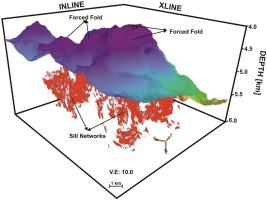当前位置:
X-MOL 学术
›
Geothermics
›
论文详情
Our official English website, www.x-mol.net, welcomes your
feedback! (Note: you will need to create a separate account there.)
Forced folding in the Kora Volcanic Complex, New Zealand: A case study with relevance to the production of hydrocarbons and geothermal energy
Geothermics ( IF 3.5 ) Pub Date : 2021-01-01 , DOI: 10.1016/j.geothermics.2020.101965 Priyadarshi Chinmoy Kumar , Tiago M. Alves , Kalachand Sain
Geothermics ( IF 3.5 ) Pub Date : 2021-01-01 , DOI: 10.1016/j.geothermics.2020.101965 Priyadarshi Chinmoy Kumar , Tiago M. Alves , Kalachand Sain

|
Abstract The intrusion of magma into relatively shallow strata often results in structural deformation. Forced folds are typically formed above intrusions so as to accommodate the addition of new volumes of magma into the sedimentary pile. This work uses a high-resolution 3D seismic volume from the offshore Taranaki Basin, New Zealand to investigate large forced folds formed in Upper Cretaceous-Paleocene sequences due to the intrusion of magmatic dikes and sills. These magmatic intrusions are related to the plumbing system of the Kora volcano. We apply a novel filtering technique to enhance the contrast between the dip-azimuth of seismic reflectors and that of any overprinting noise, preserving the lateral continuity of seismic events. Forced folds were generated by the intrusion of flat-laying saucer-shaped sills into shallow strata. These folds (Fold A and Fold B) have a domal geometry and a structural relief of 250−350 m, for a total area of 45 km2 and 35 km2, respectively. Out of the 18 interpreted sills, two sills (S1 and S4) contributed the most to the generation of the forced folds in the study area. The sill-fold relationships observed in this work suggest that sills with greater length-to-intrusion ratios deform the strata more effectively. However, it is also clear that forced folds are, in parts of the study area, larger than the intruded sills below. This hints at the presence of a larger volume of intruded magma than that imaged on seismic data where forced folds are significantly larger than the volume of the sills below. Such a character makes the establishment of fold-sill relationships crucial to the identification of magmatic bodies below forced folds - if one identifies a large forced fold on seismic profiles, but only a few small sills are imaged, then the mass of igneous rock below the fold is potentially larger than that imaged on seismic data. More importantly, forced folding in the Taranaki Basin is shown to have led to the development of four-way closures to form prolific traps for hydrocarbon and geothermal energy resources.
中文翻译:

新西兰科拉火山群中的强制折叠:与碳氢化合物和地热能生产相关的案例研究
摘要 岩浆侵入相对较浅的地层,往往导致构造变形。强制褶皱通常在侵入体上方形成,以适应将新体积的岩浆添加到沉积堆中。这项工作使用来自新西兰塔拉纳基盆地近海的高分辨率 3D 地震体积来研究由于岩浆岩脉和岩床的侵入而在上白垩统-古新世序列中形成的大型强制褶皱。这些岩浆侵入与科拉火山的管道系统有关。我们应用了一种新颖的滤波技术来增强地震反射体倾角方位角与任何叠印噪声倾角方位角之间的对比度,从而保持地震事件的横向连续性。强制褶皱是由平铺的碟形窗台侵入浅层而产生的。这些褶皱(褶皱 A 和褶皱 B)具有圆顶几何形状和 250-350 m 的结构起伏,总面积分别为 45 平方公里和 35 平方公里。在 18 个解释的窗台中,两个窗台(S1 和 S4)对研究区强制褶皱的产生贡献最大。在这项工作中观察到的窗台褶皱关系表明,具有更大长度与侵入比的窗台更有效地使地层变形。然而,同样明显的是,在研究区域的部分地区,强制褶皱比下面侵入的窗台大。这暗示存在比地震数据上成像的更大体积的侵入岩浆,其中强制褶皱显着大于下面的窗台体积。这种特征使得褶皱-地台关系的建立对于识别强制褶皱下方的岩浆体至关重要——如果在地震剖面上识别出一个大的强制褶皱,但只有少数几个小台阶被成像,那么下方的火成岩块折叠可能比在地震数据上成像的要大。更重要的是,塔拉纳基盆地的强制折叠已被证明导致了四向封闭的发展,从而形成了碳氢化合物和地热能源的多产圈闭。
更新日期:2021-01-01
中文翻译:

新西兰科拉火山群中的强制折叠:与碳氢化合物和地热能生产相关的案例研究
摘要 岩浆侵入相对较浅的地层,往往导致构造变形。强制褶皱通常在侵入体上方形成,以适应将新体积的岩浆添加到沉积堆中。这项工作使用来自新西兰塔拉纳基盆地近海的高分辨率 3D 地震体积来研究由于岩浆岩脉和岩床的侵入而在上白垩统-古新世序列中形成的大型强制褶皱。这些岩浆侵入与科拉火山的管道系统有关。我们应用了一种新颖的滤波技术来增强地震反射体倾角方位角与任何叠印噪声倾角方位角之间的对比度,从而保持地震事件的横向连续性。强制褶皱是由平铺的碟形窗台侵入浅层而产生的。这些褶皱(褶皱 A 和褶皱 B)具有圆顶几何形状和 250-350 m 的结构起伏,总面积分别为 45 平方公里和 35 平方公里。在 18 个解释的窗台中,两个窗台(S1 和 S4)对研究区强制褶皱的产生贡献最大。在这项工作中观察到的窗台褶皱关系表明,具有更大长度与侵入比的窗台更有效地使地层变形。然而,同样明显的是,在研究区域的部分地区,强制褶皱比下面侵入的窗台大。这暗示存在比地震数据上成像的更大体积的侵入岩浆,其中强制褶皱显着大于下面的窗台体积。这种特征使得褶皱-地台关系的建立对于识别强制褶皱下方的岩浆体至关重要——如果在地震剖面上识别出一个大的强制褶皱,但只有少数几个小台阶被成像,那么下方的火成岩块折叠可能比在地震数据上成像的要大。更重要的是,塔拉纳基盆地的强制折叠已被证明导致了四向封闭的发展,从而形成了碳氢化合物和地热能源的多产圈闭。











































 京公网安备 11010802027423号
京公网安备 11010802027423号